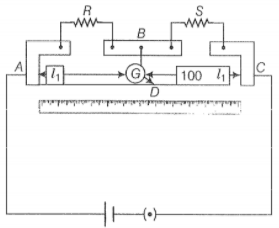Temperature dependence of resistivity \(\rho(T)\) of semiconductors, insulators, and metals is significantly based on the following factors:
| (a) | number of charge carriers can change with temperature \(T\). |
| (b) | the time interval between two successive collisions can depend on \(T\). |
| (c) | length of material can be a function of \(T\). |
| (d) | mass of carriers is a function of \(T\). |
Which of the above statements is correct?
| 1. | (a, b) | 2. | (c, d) |
| 3. | (b, c) | 4. | (b, d) |
The measurement of an unknown resistance \(R\) is to be carried out using a Wheatstone bridge. Two students perform an experiment in two ways. The first students take \(R_2=10~\Omega\) and \(R_1=5~\Omega.\) The other student takes \(R_2=1000~\Omega\) and \(R_1=500~\Omega.\) In the standard arm, both take \(R_3=5~\Omega.\) Both find \(R = \dfrac{R_{2}}{R_{1}} \times R_{3} = 10 ~ \Omega \) within errors.
| (a) | The errors of measurement of the two students are the same. |
| (b) | Errors of measurement do depend on the accuracy with which \(R_2\) and \(R_1\) can be measured. |
| (c) | If the student uses large values of \(R_2\) and \(R_1,\) the currents through the arms will be feeble. This will make the determination of the null point accurately more difficult. |
| (d) | Wheatstone Bridge is a very accurate instrument and has no errors of measurement. |
Choose the correct option from the given ones:
| 1. | (a) and (c) only |
| 2. | (c) and (d) only |
| 3. | (b) and (c) only |
| 4. | (c) and (d) only |
In a meter bridge, point D is a neutral point as shown in the figure.
| a. | The meter bridge can have no other neutral point for this set of resistances. |
| b. | When the jockey contacts a point on the meter wire left of D, current flows to B from the wire. |
| c. | When the jockey contacts a point on the meter wire to the right of D, current flows from B to the wire through the galvanometer. |
| d. | When R is increased, the neutral point shifts to left. |

Which of the above statements is correct?
1. (a, c)
2. (a, d)
3. (b, c)
4. (c, d)
Consider a current carrying wire (current \(\text{I}\)) in the shape of a circle. Note that as the current progresses along the wire, the direction of \(\text{j}\) (current density) changes in an exact manner, while the current \(\text{I}\) remains unaffected. The agent that is essentially responsible for it is:
| 1. | source of emf. |
| 2. | the electric field produced by charges accumulated on the surface of the wire. |
| 3. | the charges just behind a given segment of wire which push them just the right way by repulsion. |
| 4. | the charges ahead. |
Two batteries of emf \(\varepsilon_1\) and \(\varepsilon_2\) \((\varepsilon_2 > \varepsilon_1)\) respectively are connected in parallel as shown in the figure.

| 1. | The equivalent emf \(\varepsilon_{eq}\) of the two cells is between \(\varepsilon_1\) and \(\varepsilon_2\) i.e, \(\varepsilon_1<\varepsilon_{e q}<\varepsilon_2\) |
| 2. | The equivalent emf \(\varepsilon_{eq}\) is smaller than \(\varepsilon_1\) |
| 3. | The \(\varepsilon_{eq}\) is given by \(\varepsilon_{e q}=\varepsilon_1+\varepsilon_2\) always |
| 4. | \(\varepsilon_{eq}\) is independent of internal resistances \(r_1\) and \(r_2\) |
A resistance \(R\) is to be measured using a meter bridge. A student chooses the standard resistance \(S\) to be \(100~\Omega .\) He finds the null point at \(l_1 = 2.9~\text{cm}.\) He is told to attempt to improve accuracy. Which of the following is a useful way?
| 1. | He should measure \(l_1\) more accurately |
| 2. | He should change \(S\) to \(1000~\Omega\) and repeat the experiment |
| 3. | He should change \(S\) to \(3~\Omega\) and repeat the experiment |
| 4. | He should give up hope of more accurate measurement with a meter bridge |
Two cells of emf's approximately \(5\) V and \(10\) V are to be accurately compared using a potentiometer of length \(400\) cm.
| 1. | The battery that runs the potentiometer should have a voltage of \(8\) V |
| 2. | The battery of the potentiometer can have a voltage of \(15\) V and \(R\) adjusted so that the potential drop across the wire slightly exceeds \(10\) V |
| 3. | The first portion of \(50\) cm of the wire itself should have a potential drop of \(10\) V |
| 4. | Potentiometer is usually used for comparing resistances and not voltages |
A metal rod of length 10 cm and a rectangular cross-section of \(1~ \text {cm} \times 1/2~ \text {cm}\) is connected to a battery across opposite faces. The resistance will be:
| 1. | maximum when the battery is connected across\(1~ \text {cm} \times 1/2~ \text {cm}\) faces. |
| 2. | maximum when the battery is connected across \(10~ \text {cm} \times 1~ \text {cm}\) faces. |
| 3. | maximum when the battery is connected across \(10~ \text {cm} \times 1/2~ \text {cm}\) faces. |
| 4. | same irrespective of the three faces. |
Which of the following characteristics of electrons determines the current in a conductor?
| 1. | Drift velocity alone. |
| 2. | Thermal velocity alone. |
| 3. | Both drift velocity and thermal velocity. |
| 4. | Neither drift nor thermal velocity. |
| (a) | conservation of the current density vector. |
| (b) | conservation of charge. |
| (c) | the fact that the momentum with which a charged particle approaches a junction is unchanged (as a vector) as the charged particle leaves the junction. |
| (d) | the fact that there is no accumulation of charges at a junction. |
Which of the above statements are correct?
| 1. | (b) and (c) |
| 2. | (a) and (c) |
| 3. | (b) and (d) |
| 4. | (c) and (d) |






